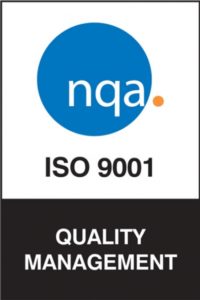
We’re proud to announce we’ve recently achieved the ISO 9001 accreditation for Quality Management Systems.
ISO 9001 is a globally recognized standard for quality management, based on principles such as customer focus, leadership, risk management, continuous improvement and process efficiency. It helps organizations improve their performance, meet customer expectations and demonstrate their commitment to quality.
The accreditation helps demonstrate our commitment to delivering the highest quality galvanizing and customer service to our customers. Achieving the accreditation means we’re now in line with the rest of the Joseph Ash Galvanizing Group, after being acquired back in October 2022.
Well done to everyone at our Widnes site on achieving the accreditation!
It’s been 200 years since Hill & Smith PLC founded, so the team at Widnes Galvanising joined in the celebrations with good food and (thankfully) good weather.
Hill & Smith was founded by Edward Hill in 1824 and was known as Hill’s Ironworks, based in Brierley Hill in the West Midlands, UK. Widnes Galvanising was acquired by Joseph Ash Galvanizing in October 2022, who in turn joined the Hill & Smith group of companies back in 2000.
Widnes’ site celebrations involved a retro burger van arriving to the site, serving delicious gourmet burgers and topped pancakes.
The burgers were certainly very unique, with buns in all sorts of different colours. The pancakes came loaded with fruit and chocolate spread, perfect for anyone with a sweet tooth.
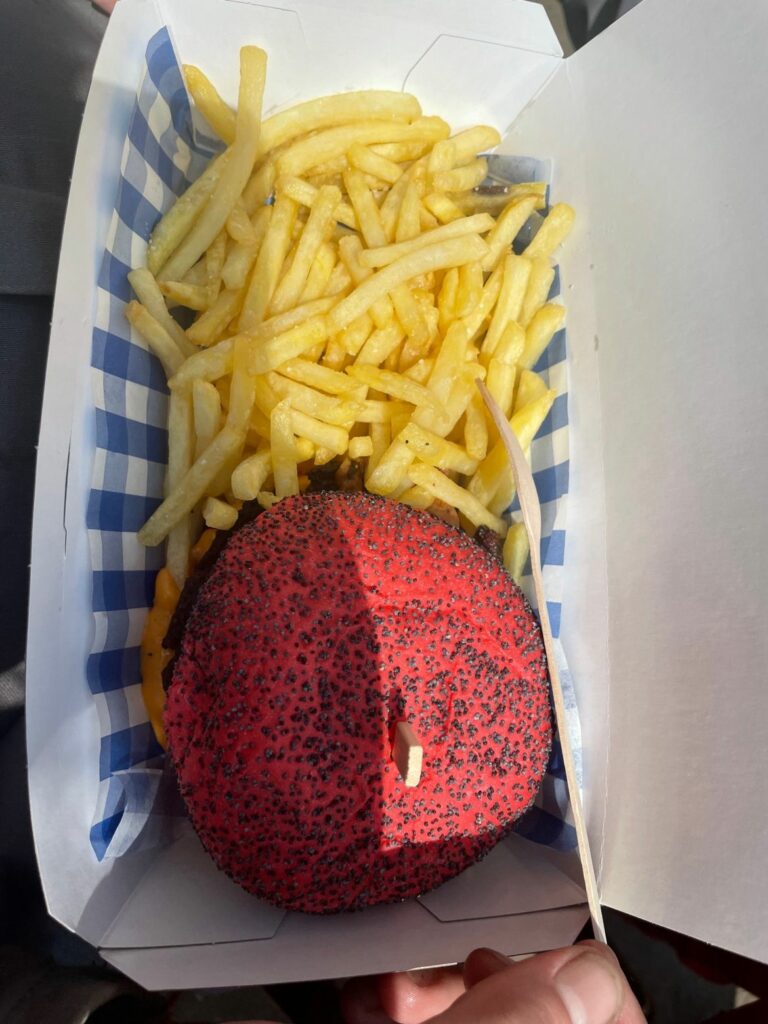

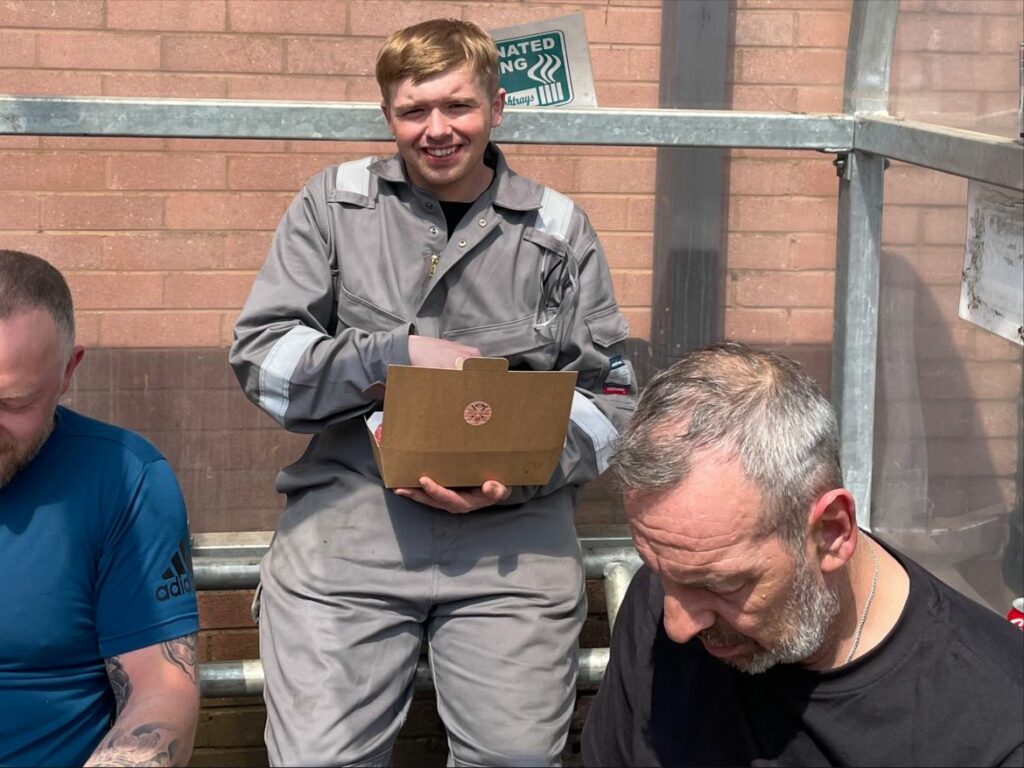
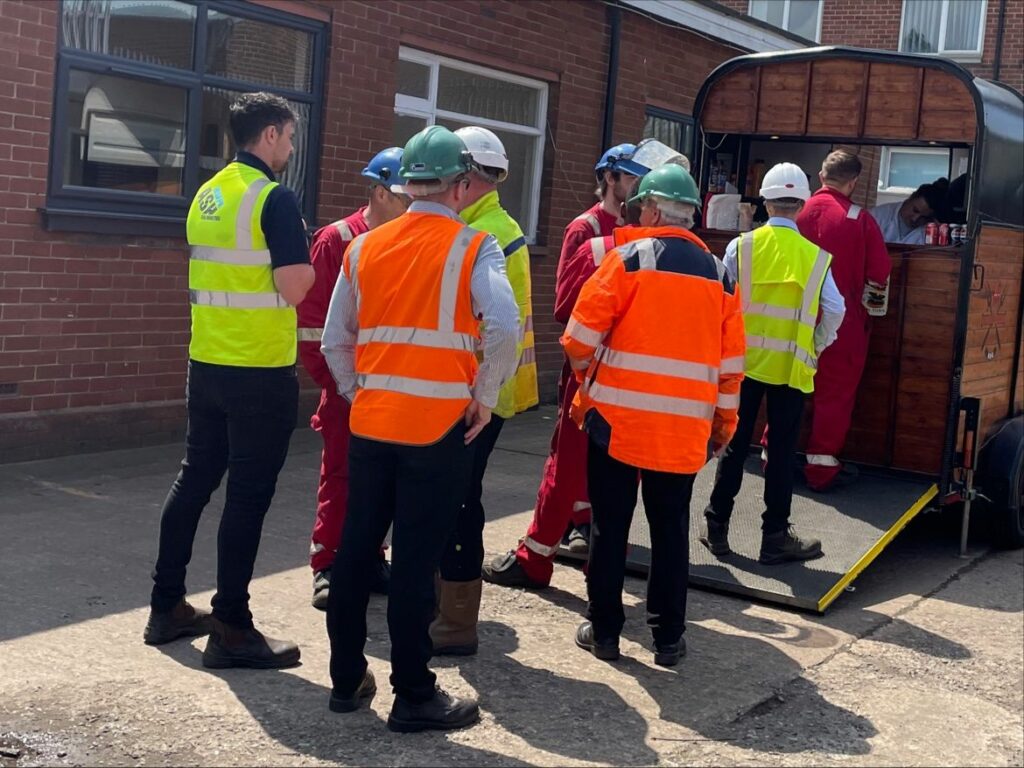

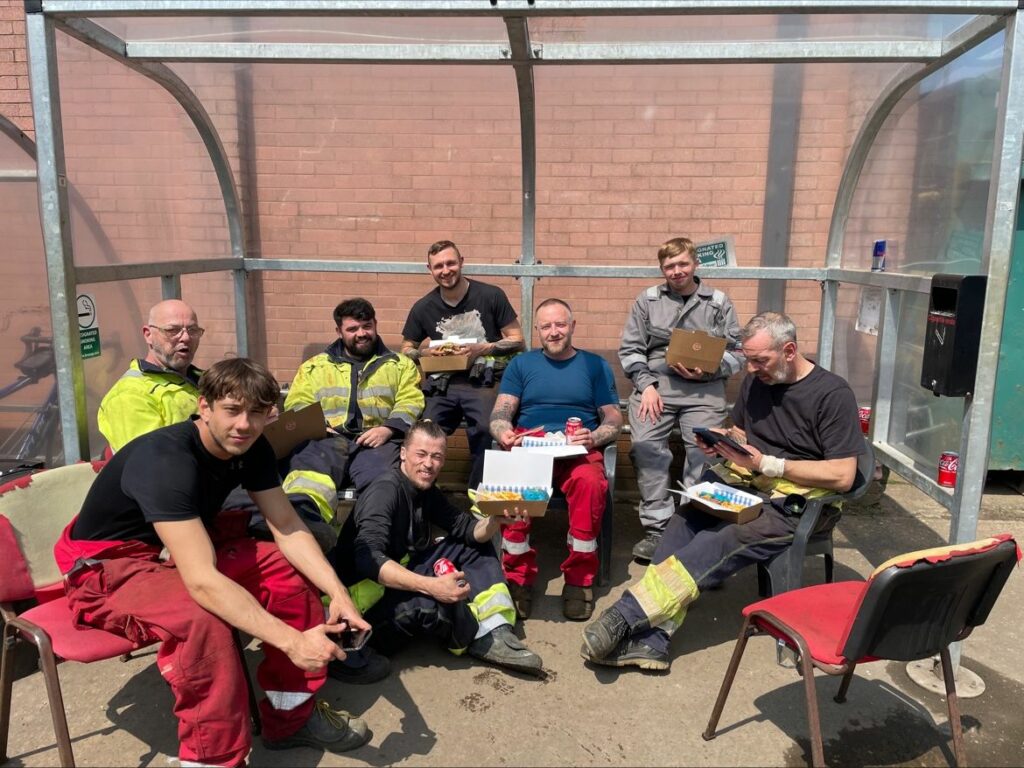
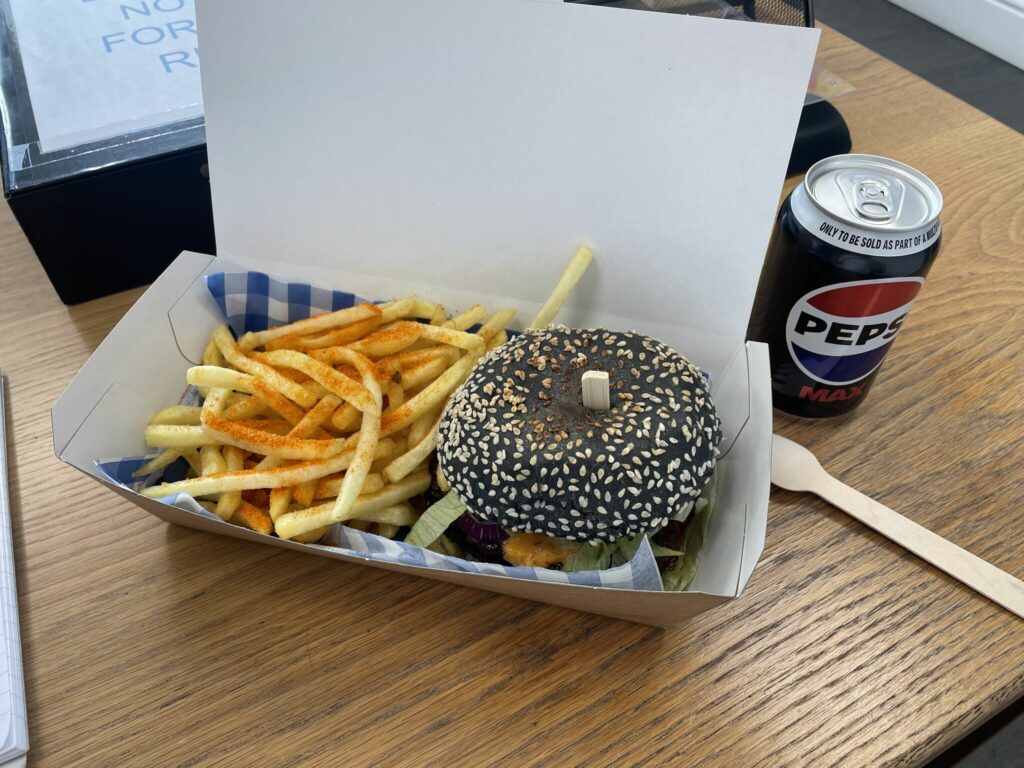
Activities are also set to take place across the other Joseph Ash Galvanizing and Premier Galvanizing sites throughout the remainder of June. We can’t wait to see what the other sites have got planned, and we can’t wait to continue to be part of Hill & Smith’s incredible history!
Next pageWe’re excited to announce that we have just launched our new environmentally-friendly passivation process!
An alternative to hexavalent chrome passivation, our new non-chrome 6 passivation is a fantastic step towards keeping the galvanising process environmentally friendly, as well as making sure we deliver only the best quality finish for our customers.
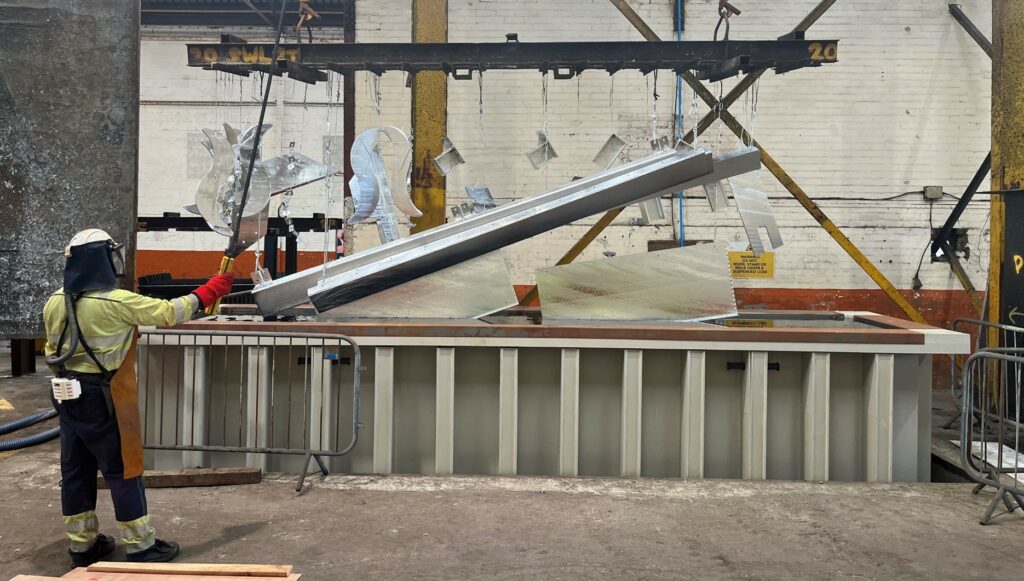
After hot dip galvanising has taken place, items (on request) are “passivated”. Passivation causes a chemical reaction to occur, where a thin transparent layer of metal oxide coats the galvanised steel to help reduce the effects of wet storage stain and cool the items so they can be handled safely.
Our new passivation process does not use hexavalent chromium (Cr(VI)) compounds within the process. Instead, it relies on compounds which are considered less toxic and more environmentally friendly. Our new method of passivating is a safer alternative to traditional Cr(VI) passivation, while delivering only the highest-quality finish for our customers.
The main difference between hexavalent chrome passivation and our new non-chrome 6 passivation is its environmental impact; Widnes Galvanising’s passivation process is more environmentally-friendly than traditional Cr(VI) passivation. Both we and the wider Joseph Ash Group are dedicated to protecting the environment, so this is a fantastic change to make.
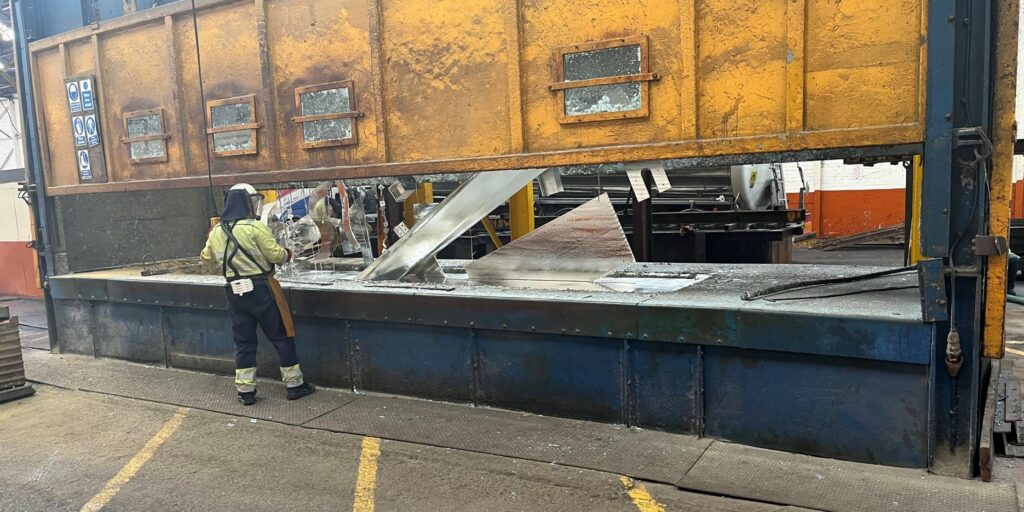
Other benefits of passivation include:
Contact us today to discuss your hot dip galvanising and passivation requirements.
Next page
Widnes Galvanising, a leading provider of galvanizing services within the Joseph Ash Group, can now bring shot blasting and powder coating services to customers. These new offerings bring Widnes Galvanising, which was acquired by the Joseph Ash Group in 2022, up to speed with other plants within the Group. Customers now have access to a wider range of finishing options, and can expect to save time and money on transportation and service fees.
Shot blasting is a highly effective process for removing rust, paint, and other contaminants from metal surfaces. It is essential for maximising the effectiveness of galvanizing and powder coating. Our other new offering, powder coating is a popular coating technique that provides a durable finish. It allows metal to be coated in a range of colours and textures while retaining the strength of galvanizing. Widnes Galvanising’s new offerings are perfect for making your steel fabrications stand out from the crowd.
We are committed to delivering the highest quality steel treatment services. With our new shot blasting and powder coating capabilities, we are well-positioned to maintain our reputation as a leading service provider within the Joseph Ash Group. If you’re near the North West area, we are ready to strengthen your steel.
For more information about Widnes Galvanising and our services, contact Gavin Jones at gavinj@widnesgalvanising.co.uk.
Next page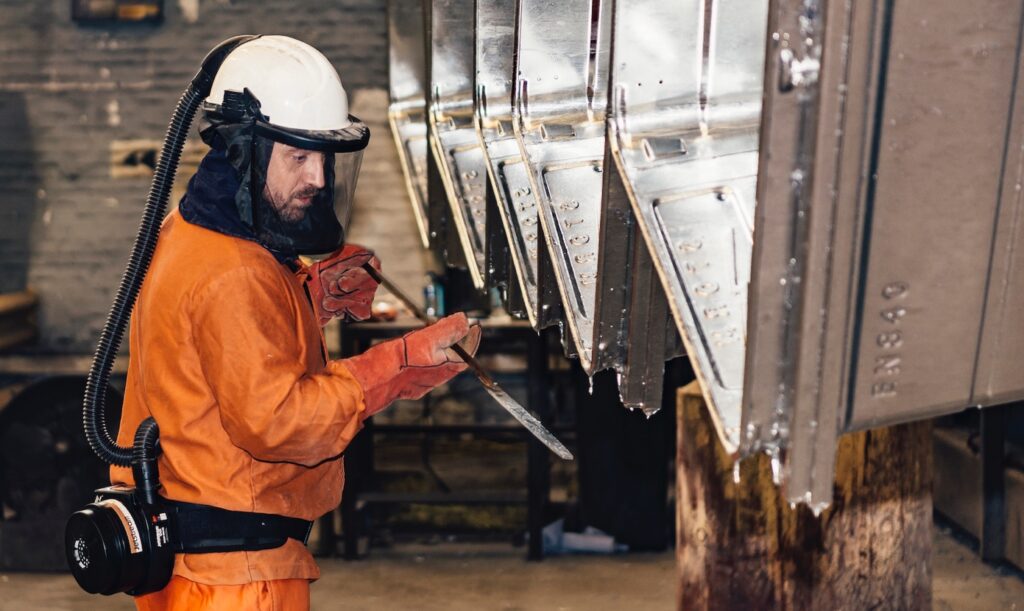
Today is World Day for Safety and Health at Work, set up by the International Labour Organisation (ILO) in 2003. The national initiative encourages and supports the need for organisations, labour unions, employers, and governments to create safe and healthy work environments to reduce accidents, illness and death for all visitors and employees.
As a Company that prioritises health and safety at work, we proudly promote this national day.
At Widnes Galvanising, our commitment to ensuring our plants are safe places to work and visit is 100%. Of course, health and safety in any workplace are essential, but they’re critical in an industrial galvanising plant.
Galvanising plants can pose considerable risks to workers if proper safety measures are not in place. This is due to heavy machinery, hazardous materials, chemicals, fumes, and baths of molten zinc at temperatures of 450°C.
By implementing health and safety policies, procedures, and systems into our culture – ensuring all directors, managers, and supervisors hold formal health and safety qualifications, and introducing an occupational health scheme to protect and maintain a healthy workforce – we have an industry-leading safety record.
We also hold OHSAS certification for exceptional health and safety standards at all plants and head office. And we’ve been awarded the RoSPA Gold Award for six consecutive years.
Find out more about the World Day for Safety and Health at Work.
See our Health and Safety Statement and our Epidemic Health and Safety Policy.
______________
About the ILO
The ILO is a United Nations agency for the world of work. Since 1919 it has brought together “governments, employers and workers of 187 Member States , to set labour standards, develop policies and devise programmes promoting decent work for all women and men.”
Next page
This year we’re being spoilt for May Bank Holidays!
Not two, but three Bank Holidays on 1, 8 and 29, with the extra one for the King’s Coronation weekend.
We hope you have some great activities planned. (Perhaps some vigorous flag waving if you’re a Royalist!)
To help you plan your projects for galvanising ahead of time, please note our plant will be closed on these days.
Enjoy!
Next page
The Easter Holidays are fast approaching, which means our opening times will be affected.
The Widnes plant (as well as other Joseph Ash Group plants) will be closed over the Easter bank holiday. If you’re looking for metal treatment services soon, please note these closures and book your galvanising projects in with us in advance.
Our plant will be closed on Friday, 7 April and Monday, 10 April 2023. We will reopen on Tuesday, 11 April 2023.
We hope you have a well-deserved break!
Next page
As the UK is experiencing high levels of inflation and energy and food price hikes, low-income families have been hit the hardest and more people are turning to food banks for help.
With Easter fast approaching, most of us look forward to our chocolate fix. However, many families can’t afford the food they need, let alone the luxury of a chocolate egg.
With this in mind, Charlie Singh (Divisional Manager) and his team at our sister plant at Joseph Ash Walsall are trying to raise as much money as possible to support Breaking Bread, a food bank in the Midlands by providing them with Easter Eggs and other food products to ensure many more families can enjoy the things most of us take for granted over the Easter period.
Please help us make a real difference by visiting the Just Giving page and donating. No matter how small, any amount will be appreciated, and you can donate anonymously (if you prefer).
Further information is on the Just Giving page.
Alternatively, it is quick and easy to donate simply by scanning the QR code.

Please dig deep, everyone deserves a Chocolate Egg at Easter!
Next pageWidnes Galvanising was acquired by Joseph Ash Ltd in October 2022 and became the ninth plant for the Group.
Gavin Jones is the new Commercial Manager for Widnes, so let’s find out a bit about him and what his plans are for the division.
Role: Commercial Manager
Branch: Widnes
Started: 2015
Food: Anything Asian (Thai, Indian, Chinese, Japanese, Malaysian, Vietnamese etc.)
Film: Step Brothers. I have a very immature sense of humour and this is right down my street!
Pastimes: Football. I’ve always played football and used to play for Saturday and Sunday football teams, but when you get older and have kids you don’t have the time anymore. However, I still play indoor football every Wednesday evening with my mates, which remains a highlight of my week.

“I’ve been a Commercial Manager since June 2020 but have been with Joseph Ash since May 2015. I previously held the position of Safety, Health, Environmental and Quality Manager at the Telford branch.
“Before Joseph Ash, I worked as a salesperson for a medical equipment supplier. I travelled all over the UK but decided to find a position closer to home when my wife was pregnant with our first child.
“I was living in Telford when a ‘Management Trainee’ position became available at the Telford branch. After meeting with Stuart Whitehouse, Stuart Cobourne and Tracie Lockley during the interview, I knew it was the kind of company I wanted to work for.”
“In my current role as Commercial Manager at Widnes Galvanising it is my responsibility to ensure the division secures sufficient sales revenue to achieve our targets.
“My day-to-day tasks include customer analysis, prospecting, and quoting all enquiries.
“Aside from the sales side of the role, I often refer to myself as a project manager, as I am the link between our customers, production and transport. I also spend many days on the road visiting customers for all kinds of reasons, such as advice on their designs and discussing pricing.
“This year I am getting far more involved with the overall running of the business.”
“My goal is to grow the business and increase our weekly tonnages by 20% while maintaining the excellent turnaround times and service. The quality of Joseph Ash’s galvanizing has always been first class, so I’m hopeful that new customers will see the benefit of using Widnes Galvanising going forward.”
“I’m a massive foodie and I’m always trying new recipes when cooking at home. I worked as a chef in a pub kitchen, and an Indian restaurant whilst I was at university. I haven’t ruled out the possibility of opening my own restaurant one day!”
If you’d like to get in touch with Gavin at to discuss your hot dip galvanizing requirements, you can reach him at gavinj@josephash.co.uk or connect with him on Linkedin.
Next pageISO 1461 – which is the British standard for hot dip galvanized coatings on iron and steel articles – has recently been updated. The new version was released in August 2022 and supersedes the 2009 version.
The standard will be adopted by CEN (the European Standards Organization) and subsequently by National Standards Bodies, including BSI in UK and the National Standards Authority of Ireland.
Several important changes have been made to the document. As the changes affect both us and you – our customers – we’ve listed them below:
Summary of Major Changes
The most significant changes to the document concern the galvanizing of ultra-low reactive steels, coating thickness measurements on ancillary elements, removal of flux residues and zinc ash, and the renovation of galvanized steelwork.
There has been no fundamental change to the method of assessment of coating thickness, but allowances for measurements on ancillary elements and ultra-low reactive steels have been introduced. The revised standard states that thickness measurements should not be taken on ancillary elements (e.g. brackets) unless specifically requested by the customer. Recognition that certain steel compositions can exhibit ultra-low reactivity during galvanizing (i.e., cannot satisfy the standard minimum coating thickness requirements) has been introduced. Articles produced from steel with a section thickness greater than 3mm which have a composition of ≤0.01 % silicon AND an aluminium content >0.035 %, that exhibit ultra-low reactivity during galvanizing, can now be subject to lower coating thickness requirements (see 6.5 below). The variation to the standard requirements must be included in the Declaration of Compliance if one is to be provided.
An important change has been made with regards to removal of flux residues. In the 2009 version, flux staining/residues were not permitted anywhere on the article, but the updated version now acknowledges that removal (including zinc ash) in some fabrications is practically impossible. Therefore, if ‘access is restricted, for example inside hollow sections’ flux residues and zinc ash are permissible.
The key changes to the content on renovation of galvanized steelwork are the requirement for the pigment in a zinc-rich paint to conform to ISO 3549 ‘Zinc dust pigments for paints — Specifications and test methods’ which has been removed but must still offer sacrificial protection to the steel; and also, more comprehensive information within Annex C – Renovation of uncoated or damaged areas.
Changes in ISO 1461:2022 vs 2009 edition
1 Scope – No significant changes were made to the scope, however clarification to clearly state the standard specifies the general properties of, and test methods for, ‘hot dip galvanized’ coatings were incorporated.
2 Normative references – There has been slight changes to the standards contained within the normative references to reflect their status within the document. Notably, ISO 14713-2 ‘Zinc coatings — Guidelines and recommendations for the protection against corrosion of iron and steel in structures — Part 2: Hot dip galvanizing’ has been included.
3 Terms and definitions – Five new terms, galvanizer (3.3), after-treatment (3.18), additional coating (3.19), wet storage stain (3.20), duplex system (3.21) have been introduced to allow for simplification of the main text.
4 General Requirements – No significant changes.
5 Acceptance inspection and sampling – No significant changes, except the minimum number of articles in a control sample can be subject to deviation following agreement within the supply chain. The new text now reads ‘Unless otherwise agreed, the minimum number of articles from each inspection lot that forms the control sample shall be in accordance with Table 1.’
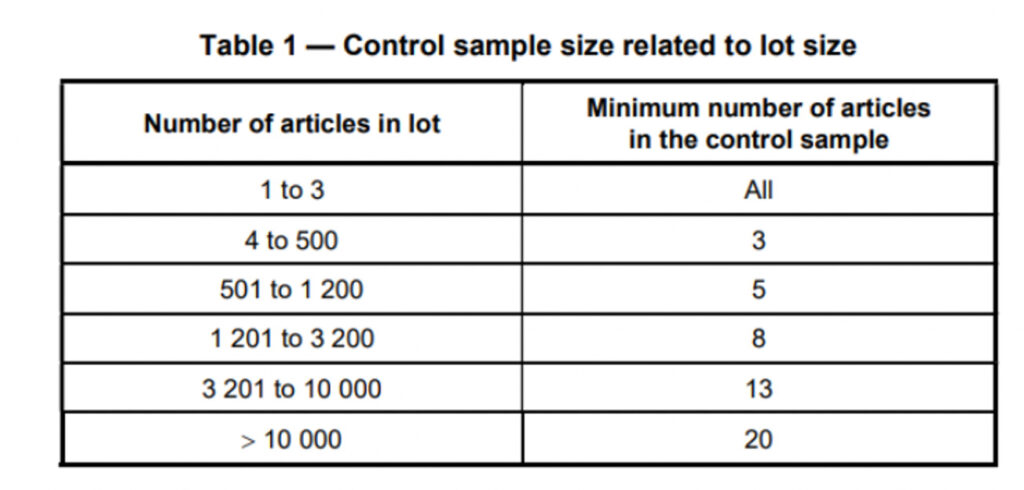
6.1 Galvanized coating properties – Appearance – Clarification has been made that only the visible significant surfaces are subject to the appearance acceptance inspection. Flux residues and zinc ash shall be removed where they can affect the intended use of the HDG article, or its corrosion resistance requirement, unless access is restricted, for example inside hollow sections. Previously, flux residues were not permitted anywhere on the article.
The coating, when first examined by normal vision from a distance of not less than 1m shall be free from blisters (i.e. raised areas without solid metal beneath), roughness and sharp points (if either that roughness or sharp point can cause injury) and uncoated areas. The 2009 version also included ‘Nodules’, however this has now been omitted from the list of prohibited coating features.
6.2 Galvanized coating properties – Thickness – The greater relevance of ISO 2178 ‘Non-magnetic coatings on magnetic substrates — Measurement of coating thickness — Magnetic method’ amongst the other coating thickness measurement standards has now been acknowledged.
6.2.3 – Reference areas – now states that ‘Unless otherwise agreed, reference areas shall not be chosen from ancilliary elements, when they are significantly smaller than the main elements of a larger article’ due to being thinner or less reactive. Acceptance that flame-cutting, laser-cutting and plasma-cutting can lead to the steel being more unreactive during galvanizing and decreased cohesion of the coating has been made. The 2022 edition now reads ‘In order to obtain the required coating thicknesses more reliably and to ensure adequate cohesion or adhesion of the coating, flame-cut, laser-cut and plasma-cut surfaces should have been ground off and sharp edges should have been removed during fabrication and prior to delivery to the galvanizer.’
The minimum size of a reference area is now clearly defined as being 10cm2.
6.3 – Galvanized coating properties – Renovation – The circumstances where a lower (than 100μm) minimum repair coating thickness can be agreed, has been expanded to account for thinner galvanized coatings around the damaged area, for example, where aesthetics may be important.
6.4 – Galvanized coating properties – Adhesion – No significant changes, however a new ‘note’ has been added which recognises that cohesion of the galvanized coating can be affected by a steel being ultra-low reactive – as defined in ISO 14713-2 Table 1, Note 4. There is still not a suitable international standard for testing the adhesion of galvanized coatings.
6.5 – Galvanized coating properties – Acceptance Criteria – It is within this section where the adjustment for ultra-low reactive steels has been introduced. The new text reads:
‘For articles with steel section thicknesses greater than 3 mm, produced from steels with compositions ≤0,01 % silicon that also have aluminium contents >0,035 %, that exhibit ultra-low reactivity during galvanizing and therefore cannot satisfy the minimum galvanized coating thickness in Table 3, the next lowest category of steel article section thickness given in Column 1 of Table 3 shall be applied. In such cases, if a declaration of compliance must be provided then it shall state this variation including the adjusted minimum mean galvanized coating thickness requirement that has been applied to the inspection lot.
NOTE – Certain steels, including but not limited to, either steels suitable for laser cutting with chemical compositions as given in ISO 14713-2:2019, Table 1, Note 4 or steels with high surface smoothness, or both, can exhibit ultra-low reactivity during galvanizing (see ISO 14713-2) and the coating thickness achieved on such steel articles can possibly not be dependent on steel section thickness. These factors are beyond the control of the galvanizer and can also result in even lower coating thicknesses than given in the next lowest category of steel article section thickness given in Table 3.’
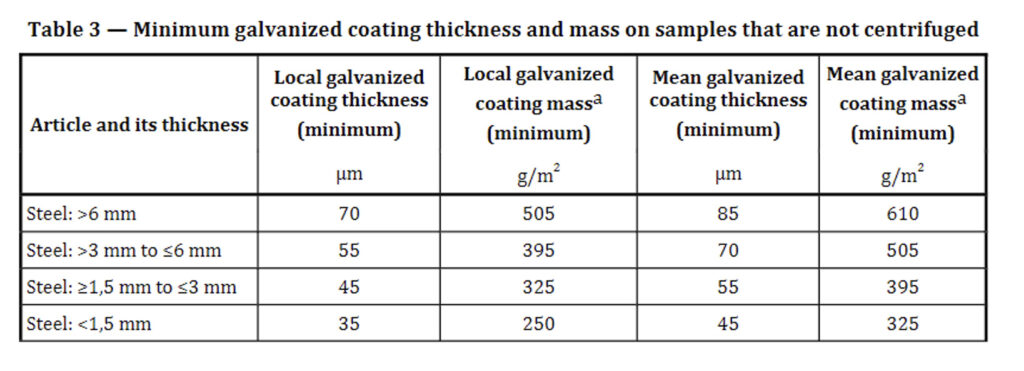
7 – Declaration of Compliance – The terminology has been modified, in ISO 1461:2009 this was referred to as a ‘Certificate of compliance’ whereas now it is called a ‘Declaration of compliance’. Clarification that this must meet the requirements of ISO 10474 ‘Steel and steel products — Inspection documents’ has been incorporated.
Annex A (normative) – Information to be supplied – An important sentence has been added to A.2– Additional information for provision by the purchaser, which states that ‘an indication of any ancillary elements within the article that must be considered as part of the significant surfaces from which reference areas might be taken (e.g. if the ancillary elements are safety critical).’ This is to account for the default procedure of not taking coating thickness measurements on ancillary components.
Annex B (normative) – Safety and process requirements – Venting and Drainage of Articles – Verification has been incorporated into this Annex that states the work presented for galvanizing should be in accordance with ‘either the guidance given in ISO 14713-2 or any further specific guidance for the articles to be processed that may arise from consultations with the galvanizer, or both.’
Annex C (informative) – Renovation of uncoated or damaged areas – Annex C contains considerably more guidance on the requirements for a zinc-containing paint used for repair than the previous version (Annex C.1 – Zinc-containing paints). See new guidance below.
‘A dry paint film that is capable of conducting electricity and which is in electrical contact with the basis metal will ensure that sacrificial protection is provided.
Other things being equal, sacrificial protection increases with increases in metallic zinc content in the dried film but does not increase further above approximately 94% by weight of zinc for paints containing zinc dust. However, other factors can be important.
A zinc-containing paint with a zinc dust content that is equal to or greater than 80% by mass in the dry film can be considered suitable for renovation of uncoated or damaged areas. Conformity of the zinc dust pigment, within a zinc-containing paint, with ISO 3549 is a further indication of suitability.
Zinc-containing paints based on lamellar shaped, rather than spherical, zinc particles may achieve adequate protection at lower contents of zinc in the dry film than for zinc dust paints with spherical particles.
Zinc-containing paints may also include an aluminium content for aesthetic purposes.’
Annex D (informative) – Determination of thickness – No significant changes.
Annex E (informative) – Corrosion resistance of galvanized coatings – Annex E has been updated to include supplementary information regarding the long-term, steady-state zinc corrosion rates given in ISO 9224 ‘Corrosion of metals and alloys — Corrosivity of atmospheres — Guiding values for the corrosivity categories.’ This is in appreciation that ISO 14713-1 ‘Zinc coatings — Guidelines and recommendations for the protection against corrosion of iron and steel in structures — Part 1: General principles of design and corrosion resistance’ provides first year exposure corrosion rate data and is therefore conservative guidance.
Further information and support
If you have any queries regarding the updated standard, please contact the Widnes Galvanising Technical Team. You can also contact GA Technical department regarding the updated standard or its interpretation. In the first instance, call their free ServiceLine on tele: +44 (0)121 355 8838 or email Dr Desmond Makepeace at d.makepeace@hdg.org.uk.
Next page